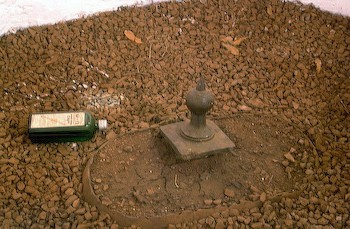|
Okomfo Anokye (active late 17th century) was an Ashanti
priest, statesman and lawgiver. He occupies a Merlin-like
position in Ashanti history. A co-founder of the Empire of
Ashanti in West Africa, he helped establish its constitution,
laws, and customs.
The original name of Okomfo Anokye was Kwame Frimpon Anokye (Okomfo
means "priest"). Some traditions say that he came from
Awukugua-Akwapim in the Akwamu Kingdom southeast of the Empire
of Ashanti, but his descendants claim he was simply born in
Kumasi of a mother and father from Awukugua-Akwapim. At any
rate, he was introduced to the military leader Osei Tutu (the
other co-founder of the Empire of Ashanti) by a maternal uncle.
When Osei Tutu succeeded about 1690 to the leadership of the
small group of Akan forest states around the city of Kumasi
which were already grouped in a loose military alliance, Anokye
was his adviser and chief priest. Tutu and Anokye, who must be
considered together, carried out the expansionist policy of
their predecessors, defeating two powerful enemies, the Akan
Doma to the northwest and the Denkyera empire to the south. It
was and still is said by the historians of Ashanti that their
people are descendants of the great Mali Empire, which is said
to have given them their knowledge and war-like nature. The
Ashanti conquered large parts of Ghana during the 17th century
by overthrowing their powerful overlords, the Denkyera. Okomfo
Anokye was essentially a powerful cleric who served to rally the
people to the cause of his king. The Okomfo is also said to have
placed a dagger in the middle of the Ashanti region in Ghana
which the Europeans have not being able to take out with any
type of technology for over around 500 years. Ashanti was one of
the fews regions in West Africa to achieve victories against the
British in battle.
To throw off the Denkyera yoke required a powerful unity that
transcended the particularism of the Ashanti segments, and
Anokye employed not only the political influence of his
priesthood but also the spiritual ties it engendered to
transform the loose Ashanti alliance into a "national" union in
1695. Anokye and Tutu established rituals and customs of the
Ashanti state to diminish the influence of local traditions.
They designated Kumasi the Ashanti capital. They then
established a state council of the chiefs of the preexisting
states admitted to the union and suppressed all competing
traditions of origin. Finally, they reorganized the Ashanti army.
The war with Denkyera from 1699 to 1701 went badly at first,
but when the Denkyera army reached the gates of Kumasi, Anokye's
"incantations" supposedly produced defections among their
generals. The Ashanti broke the Denkyera hegemony and captured
the Dutch deed of rent for Elmina Castle. This gave the traders
of the empire access to the African coast and involved them
henceforth in the commerce and politics of the coastal slave
trade. After Tutu's death in 1717, Anokye is said to have
returned to Akwapim and died there. The real cause of his death
is not known.
Komfo Anokye Sword
 Just behind the Okomfo Anokye Hospital, one will find the
Okomfo Anokye Sword. It is named after a famous traditional
priest who, in the 17th century, was said to have conjured the
""Golden Stool"" from the sky. Legend states that as high priest
of the Akan kingdoms, he drove his sword into the ground with
such force that it has remained there ever since, marking the
site of the new imperial city, Kumasi, which unified the Akan
kingdoms. The site is revered by all as a sacred shrine. The
unmovable Sword of the Komfo Anokye remains in the grounds of
the Okomfo Anokye Teaching Hospital, where he pushed it. It is
believed the Komfo pronounced that no one would be able to
remove the sword, and so it has remained in spite of many
attempts. Just behind the Okomfo Anokye Hospital, one will find the
Okomfo Anokye Sword. It is named after a famous traditional
priest who, in the 17th century, was said to have conjured the
""Golden Stool"" from the sky. Legend states that as high priest
of the Akan kingdoms, he drove his sword into the ground with
such force that it has remained there ever since, marking the
site of the new imperial city, Kumasi, which unified the Akan
kingdoms. The site is revered by all as a sacred shrine. The
unmovable Sword of the Komfo Anokye remains in the grounds of
the Okomfo Anokye Teaching Hospital, where he pushed it. It is
believed the Komfo pronounced that no one would be able to
remove the sword, and so it has remained in spite of many
attempts. |